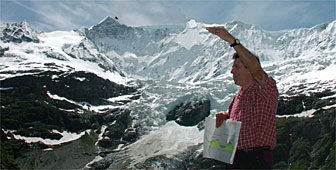Marking glacial change on Grindelwald’s trail

There are few places in the world like the Bernese Oberland resort of Grindelwald where it is easy to cosy up to a glacier and see firsthand the changes under way.
Climbing the trail to the Lower Grindelwald Glacier, Hans-Peter Holzhauser, a leading glaciologist from the University of Zurich, notes the alarming rate at which the Grindelwald is retreating.
For the layman venturing along the trail on a hot summer day, the deep gorge and high moraine walls carved out by the glacier confirm headlines that global warming is a reality. The rumble of ice tumbling in massive chunks punctuates the climb and seems to underscore the issue of glacial retreat.
“It has receded about 1.6 kilometres since the forward mark of its last advance in 1850 or 1860,” Holzhauser says of the Lower Grindelwald. Paintings and written records make such statements about recent glacial history easy to verify.
And visiting the region turns up more evidence. Holzhauser’s investigation of the glacier’s 10,000-year post ice age history has required him to explore the glacier and its moraines on foot.
Trees help chart advance
“Old trees found in the moraines can be radiocarbon dated to find out when a glacier has advanced, and when one finds many trees one can hazard a guess as to how often a glacier advanced in the post ice age.”
Standing 400 metres above Grindelwald, Holzhauser helps students from Zurich University get their bearings. “To the left” he says, “is the ‘Kleine Scheidegg’, or small watershed. The Faulhorn Mountain is directly across from us. Many people go to the top to enjoy the wonderful views of the Eiger, Mönch and Jungfrau peaks.”
Holzhauser then leads the group along the trail back toward the Lower Grindelwald Glacier, which he has spent the last 15 years of his life researching.
“My work has focused on the history of the glacier and I want to present that to the students, particularly the post ice age history,” he says.
It’s an impressive trail, at first shaded by a stand of pine trees, then hugging the side of a cliff, passing under a series of small waterfalls, which shower down into the moraine and gorge below.
Holzhauser stops the group to point out geographic signposts of the glacier’s advance during the mid-19th century. At that time it extended to the valley floor.
Although cautious with his predictions, he says glaciers do represent “sensitive indicators of climate change”. And temperature fluctuations, based on his research, are rapidly heading “towards or even beyond the ‘warm’ limit of natural variability over the last 5,000 years”.
A couple of workers repair the path where it takes on a zigzag course to overcome about 100 metres in altitude. The men lay new soil and create steps with logs.
Folds from the sea
Holzhauser brings to the students’ attention a white layer zigzagging through the rocks beside the path. He calls it evidence of the formation of the Alps millions of years ago when strata from the northward moving African landmass squeezed against Eurasia, creating folds that rose from the sea.
At the top of the path, the students find an unobstructed view of the glacier. It’s only a short walk to the restaurant “Stieregg”, where hikers sip refreshments on the terrace and listen to the thunder of the constant icefalls.
The glacier has its peculiarities. Holzhauser motions toward a mass of exposed rock called the “hot stone.” Too large to be enclosed by ice, it got the nickname from locals who thought the rock too hot to be covered by ice.
The glaciologist directs his students’ attention to a tree trunk projecting from the moraine below the restaurant. He wants to excavate it for his studies.
“We are trying to reconstruct a complete picture of the periods of advances and recessions in the post ice age,” he says. “We’re mainly concerned with the recessions, because we want to know how extensive they were so we can better evaluate the present climate.”
by Dale Bechtel

In compliance with the JTI standards
More: SWI swissinfo.ch certified by the Journalism Trust Initiative

You can find an overview of ongoing debates with our journalists here. Please join us!
If you want to start a conversation about a topic raised in this article or want to report factual errors, email us at english@swissinfo.ch.